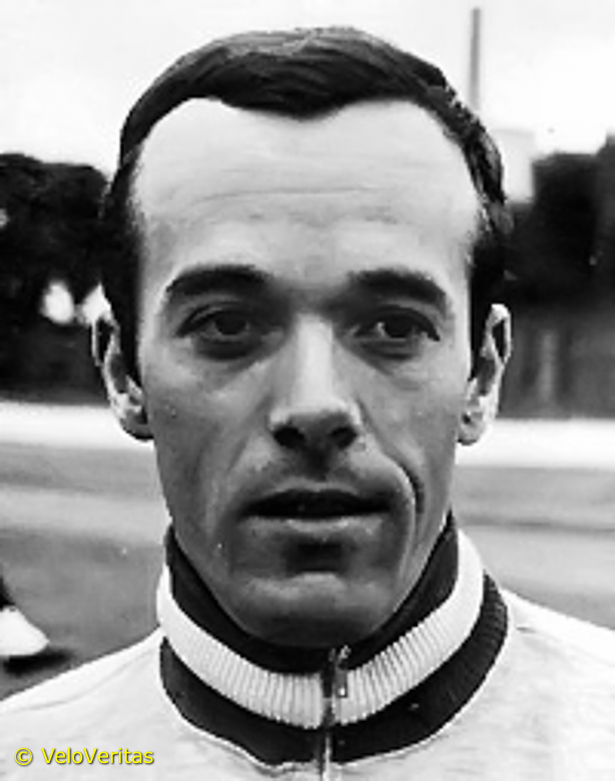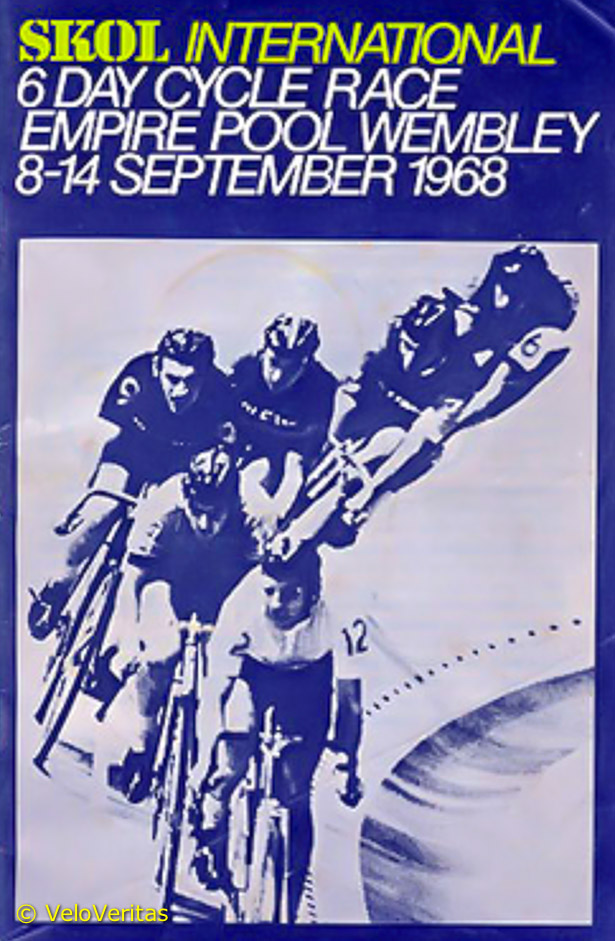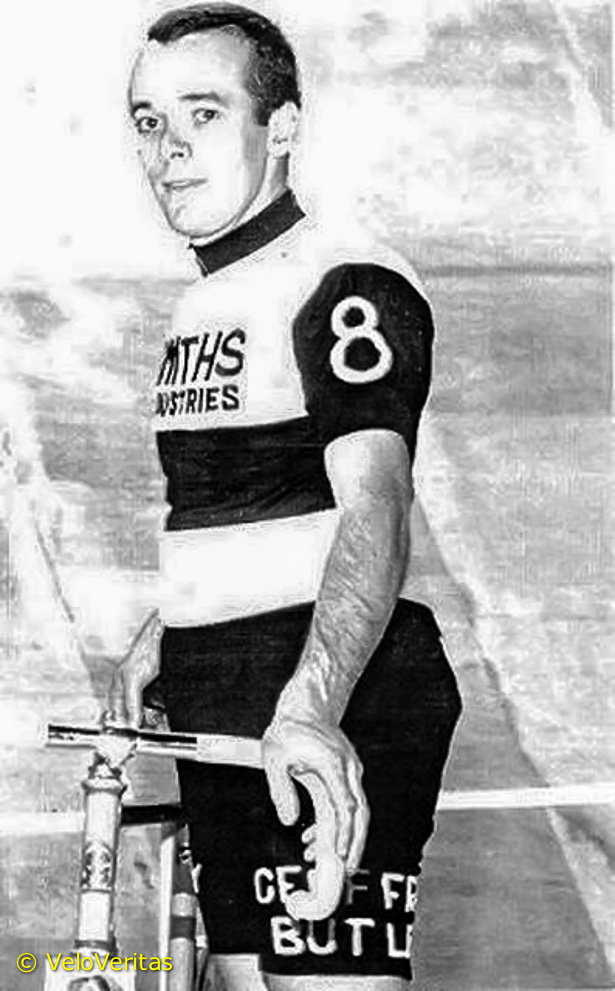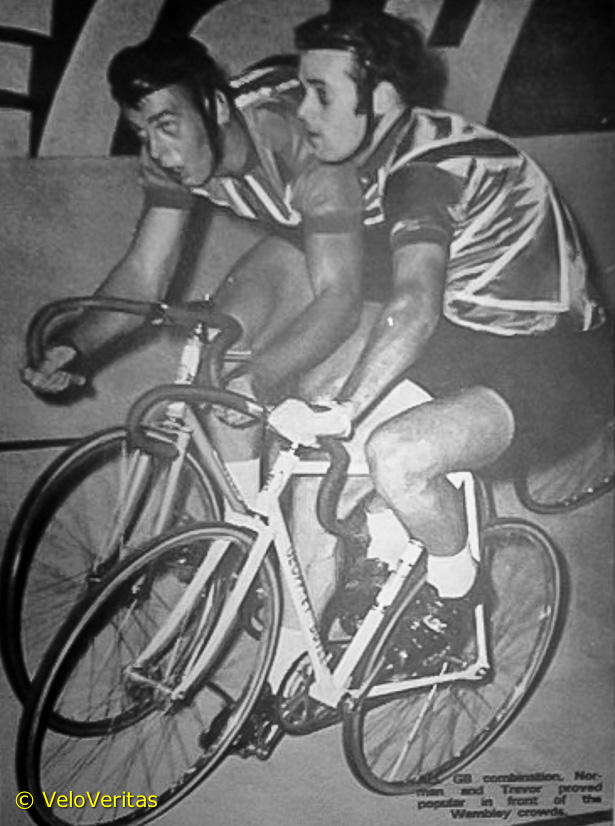
With just about everything on ‘hold’ awaiting le Tour kicking off in Yorkshire, we thought we’d slip back through the decades to a different era.
One where the ‘big motors’ were still the thing; Six Days packed them in and pave didn’t just come in two kilometer packages.
You may not have heard of Englishman, Norman Hill – but he has the T-shirt, video and DVD as a ‘stayer,’ Six Day man and kermis rider on the hard roads of Flanders and The Netherlands.
Here’s his story.
How did you get into the Six Days, Norman?
“The London Skol Six in 1967.
“Dutch promoter Charly Ruys put on a series of madisons through that summer and he signed UK riders who rode those selection events.”
How did you get the contracts?
“You ride one, and the word is out there. The Six Day manager at the time was Fons Versnick a former rider. He liked the idea of specialist and focused track riders along with the road champions to pull the spectators in. That first winter I rode four Six Days.
“I had lived over in Switzerland for five years and rode madisons on Zürich’s Oerlikon-Hallenstadion 250 metres track; Basel 140 metres track which was like a cigar/wall of death; and with Brian Dacey in East Germany on another shorty track around 140 meters, for a few weeks.
“As an amateur I had quite a few madisons under the belt including several times each evening for a week before Zürich Six Days riding with the pros.”
Tell us about the London Earls Court Sixes?
“Earls Court went well, combined with the bike show, lots of spectators – and the money was especially good the first time. There were the usual tumbles, one time Dave Bonner locked bars with Gerard Koel and brought everyone to the ground.
“It put “Patto” (Sid Patterson) along the ballestrada (railing) and off to hospital. They told him at his age 40, he needs to get plenty of rest. He came straight back to the Six and carried as if nothing had happened!
“In the very first “devil” Post tried to shut me out – I stayed put and he had nowhere to go and a bunch of us hit the deck!
“He was furious until Tassie Johnson (1970 world sprint champion, Gordon’s Dad) jumped down from the crowd and promptly told Post it was his own fault.”

And the Skol Six Days?
“I rode the first three London Six Days and then was canned because I was living in Holland and never rode Webb’s selection events; that was his excuse. I had made the effort that year to ride the National Motor Paced Championship in Manchester, bringing top continental pacer Bruno Walrave with me and we won it by a couple of laps. But it didn’t mean enough for me to be contracted again for the London Six.
“Other excellent UK riders were not given a second chance – like Jim Moore who was as fast as Rene Pijnen in a chase; plus numerous talented home based riders not even given the opportunity.”
Which other Six Days did you ride?
“Zürich, Rotterdam, Groningen, Munster, Montreal, Los Angeles, Detroit; 16 in total.”
Which Six Day performance gives you most satisfaction?
“Groningen – I met my wife at the second of the three, she was the “podium Miss” plus I had a lot of fun riding each one with Piet van der Lans. For the first Groningen Six I had bought a black London Cab for some fun.
“Even when in London people would jump in and could never figure out why a bike was on the back seat, I’d just say, some bloke left it there! Each time picking up a 10 quid fare…
“Back in Holland at the Groningen Six we plastered it with posters promoting the event. On the first night of racing, a group of students started rooting for Piet and me, so I jumped into tribunes to meet them all. As it turned out, one of them had tried racing for a short while.
“Those students started the huge support in Groningen for Piet and I – later I assisted Piet in getting his first job outside cycling as a journalist. Years later in 2000 he brought the Giro start to Groningen.
“Piet was famous for pulling off all kinds of stunts. One afternoon he climbed up to the platform where the “lap standings” were posted for all the spectators to see before the afternoon session started. He switched them around a little and put Post and partner in last position, we were in second. Piet then kept the ladder to get up there.
“Of course Post was livid, Piet chuckling later that; “we’re in for a tough night tonight!” But I have to say Post and Co took to the jokes in their stride and were always very professional and friendly.
“Mind you that was nothing to Tommy Simpson at the Antwerp Six one time…
“A circus troupe was there along with some animals. Tom let a monkey out of its cage and it scrambled up into the rafters and stopped the “show” for several hours before the monkey was coaxed back down, caught and returned to its cage. The track director Theo Balemans was really miffed.”

You were also a ‘stayer’ – how did you get into that?
“I knew quite a bit about pacing growing up as my Dad was a member of the Imperial Wheelers in the 20’s and 30’s along with Harry Grant (Grant was a English top motor pace rider, between the wars, holding world records, ed.)
“For me in the 50’s as member of the Kentish Wheelers, they had a lot of trackies including Gerry Waters who was famous for his tandem pacing.
“When living in Switzerland in the early 60’s, Hugo Koblet (legendary Swiss cyclist who won the Tour de France and Giro d’Italia) bugged me every time we met – which was quite often – at the indoor and open track in Zürich and the amateur road races that he was often at. He would always say to me; “you’d be good behind the motors.”
“One time around ‘62 he even had a bike ready for me to jump on at the Hallenstadion but it looked so ancient at the time I gave it a miss! Several years passed – whilst I lived in The Netherlands – before I rode my first paced event. Although my fellow Englishman George Halls had a good go at it in ’68.
“George must have been back in the UK in ’69 and that autumn when I showed up at the Sports Paleis Antwerpe for training, wow and behold “I’m on the poster” for the next weekend’s paced meet riding behind Bruno Walrave. I’d ridden the European Derny Championships a year earlier behind Bruno and that was my initiation. He had a bike ready – a decent one, and a couple of sessions in the week and away we went on the Saturday night!”
Did you ever ride the Worlds stayers?
“Four times – Antwerp, Leicester, Italy and in France. The BCF never paid any expenses for the pros, unless you made the podium and that would come afterwards from the UCI. With no top UK pacers involved in the European circuit it was a question of hiring a European pacer who was available.
“I could get to the final but then the National Federations took all the top pacers for their riders. In my last year active Six Days were planned for the US; the track “Worlds” were in Spain that year but the rider had to have a pacer from the same nationality and with no UK pacers in Europe that cut me out. That was the time to move on, ride the planned Six Days in North America and see what happens. I had seen too many riders carry on too long and I knew that wouldn’t happen to me.
“Imagine, no financial support whatsoever simply because a rider was a pro – by the BCF at the time – it’s different now, and good luck to the modern riders, they deserve it.”
What was the scene behind the big bikes like in the 60’s/70’s?
“The riders and pacers were a great crowd, some I still have good contact with: Piet van der Lans, Dieter Kemper, Amalio Hortelano, Nico Been, Jabbie (Jaap) Oudkerk, Cees Stam, Piet De Wit, Theo Verschueren, Hennes Junkerman, Nico (Domenico) de Lillo and the rest.
“The pacers too were all special having been in the sport going back to the 30’s, 40’s and 50’s. I spent a lot of time with Bruno Walrave and Noppie Koch. Bruno grew up only wanting to be a pacer at the Olympic Stadium, Amsterdam and Noppie was a top rider before switching from behind the roller to controlling the throttle.
“There was a popularity decline in pro stayer racing though, with fewer spectators between when I first went to the track in Zürich in the early 60’s and the early 70’s. Although it remained very popular in the Eastern Bloc countries.
“Going back to the previous “heyday” times of track racing, the big names were always there on the boards. Road champions, be it Van Steenbergen, Van Looy, Merckx, Sercu, Junkermann, Altig, Post, even Anquetil, Darrigarde, Koblet…
“Coupled with the superstars on the track, Jan Derksen, Sid Patterson, Oscar Plattner (world sprint champion with the pro’s and he even got a fourth in the worlds RR one year), Palle Lykke (got fourth in the amateur worlds RR when he was 17, the year his future father-in-law ‘Rik 1’ took the worlds in Denmark) Kemper, Bugdahl, Renz, Eugen, Roth, Bucher, Strom, Arnold, Teruzzi and so on.”

You road raced in Switzerland, why there and what was the scene like?
“I finished an apprenticeship in machine shop engineering, missed National Service and decided to race somewhere in Europe. Switzerland came up through my brother who had spent time in the services with Syd Merron (former BCF 10 mile track champion) – who now lives in Washington State.
“Syd passed me onto his brother in law Peter Hayhurst as he was at the time living and working just outside Zürich. Peter sent a whole bunch of ads and from there I quickly got work as a tool and die maker. It was with Peter who I rode my first board track madison with.
“Only in the last year or so, having reconnected with Peter did he tell me he is the nephew of Syd Cozens, (British world amateur sprint championship medallist between the wars.) The racing in Switzerland and surrounding countries was pretty good. Prizes were great; far better than the UK, often with fields of 150 – 200 starters on closed roads and through the summer plenty of 80 – 100 km crits.
“Often the road event took in long stretches of “nature strasse” like the new Italian classic “Strada Bianche.” I was a ‘weekend warrior,’ working in the week and racing weekends with the occasional trip to Zurich to ride the track at Oerlikon-Offene Bahn. The times when it rained there, we just went across the street and raced on the 250-meter indoor Hallenstadion track that now has been removed.
They have a Four-Day (the Six Day Nights of Zürich, ed.) on a portable 200 meter track there now in the winter. On occasions I would get invited to crits in Germany or Austria. Through the summer there were the occasional three day stage races that were always a great way to see the country.
“I know that at my work I had been to so many more places in Switzerland than my co-workers who had lived a lifetime there.”
Can you tell us about which pro teams you rode for – Goldor Hertekamp in 1969 looks interesting!
“I rode a year with them. Essentially they wanted you to have a beer delivery round – either one of your supporters to have one or run it in your spare time.
“Living in Holland that never worked although I have to say the beer was good. Any contract money was always pretty minimal so the way to go was start money and prize money. Nearing the end of one kermis, a team mate came up and asked if I could bridge him across the 300-meter gap to the small group of leaders ahead with about 1500 meters to go.
“I stuck it in the 13 and caught them just in time for the sprint – six months later, we met at the Antwerpe Sports Paleis for a meet and he gave me an envelope with half of his first placed winnings.
“Robert had won the kermis where I took him up and over the next few years went on to win two world pro sprint titles and stand on the podium five times – Robert Van Lancker.
“Riding both the road – mainly crits – and the track through the summer essentially behind the motors with the odd track omnium thrown in meant there was always cash flow. Geoffrey Butler Cycles in Croydon were always super supportive of me no matter where I was living – either in Switzerland or Holland. The Roberts frames Geoffrey Butler Cycles supplied were top notch.”
What were your best road performances?
“I never really looked upon best performances.
“The best I had on the road were several fourth places in ‘crits’ – a lot of times in the top 10, plenty in the top 20 in both Holland and Belgium.
“It augmented the track meets which I rode summer and winter.
“Looking back there was not the structure like now and I certainly was not ‘intensive’ like so many of the great riders of the time.”
Follow Norman’s story in Part Two of our interview.



